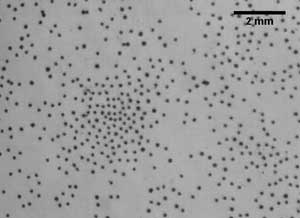| Posted: Sep 25, 2018 | |
Study of tiny vortices could lead to new self-healing materials, other advances(Nanowerk News) In the Wizard of Oz a tornado picks up Dorothy’s house and moves it far away. A bit farfetched, right? But scientists at the Department of Energy’s (DOE) Argonne National Laboratory think that, on a much smaller scale, tiny vortices could one day be used to move microscopic particles. |
|
| The vortices could one day be used in lab-on-a-chip designs to move particles, like blood cells, from one place to another, or to build materials with self-healing properties. | |
| Before they can harness the tiny vortices, though, scientists need to understand how their components, or colloidal particles, form and function. By exposing groups of microscopic metal magnetic rollers to various magnetic fields, Argonne physicist Alexey Snezhko and postdoc Gasper Kokot are creating their own vortices to accelerate that understanding. | |
| “Transporting objects is a far reaching goal, but we’re working on the first steps, which is to understand the basic principles,” Snezhko said. "We are doing this as a search for a new kind of active material. Materials existing out-of-equilibrium.” | |
 |
|
| Argonne researchers suspect these magnetic particles can actually talk to each other in a manner similar to birds to avoid each other in flight. (Image: Argonne National Laboratory / Alexey Snezhko.) | |
| The pair published recent findings in Nature Communications ("Manipulation of emergent vortices in swarms of magnetic rollers"). | |
| In their first series of tests, researchers put about 100 miniscule magnetic nickel rollers, or spheres, in a water matrix exposed to a single axis magnetic field, followed by an alternating magnetic field. | |
| “Each particle is like a small compass,” Snezhko explained. "And we use a magnetic field to transfer energy.” | |
| Within the single magnetic field, the rollers lined up as if they were indeed part of a compass needle, but when exposed to a magnetic field that changed orientation 60 times a second, the rollers instead flocked together and formed vortices. | |
| In the experiments, the vortices were allowed to move freely in the water matrix, where researchers studied their natural behavior. When exposed to the flipping magnetic field, the particles flipped as well and started to roll. | |
| “This is the only known system where we’ve seen this type of rolling and self-organization with this flocking behavior, "Kokot said. "The group moves as one, just like a flock of birds.” | |
| As the particles flock together, the system spontaneously forms a vortex, but the vortex also has some strange properties, like inexplicably switching directions. In their study, the vortex switched rotational direction on average once every 160 minutes. | |
| “We would like to know why it switches, what controls the rate of switching,” expressed Kokot. "Because if we can control it, we can start talking about utility.” | |
| The researchers suspect the magnetic particles can actually talk to each other in a manner similar to birds to avoid each other in flight. And the hope is scientists can eventually use the knowledge to self-assemble and transport structures in the microscopic world. | |
| There’s a lot more to study before scientists will fully understand or be able to control the vortices, but Snezhko said he thinks that, eventually, they could be used like tweezers, moving non-metallic particles in and out of a liquid matrix. | |
| “This vortex interacts with particles through liquid,” he said. "It can capture a particle inside and move it.” | |
| But it’s not a one-size fits all solution, Kokot said. Particles being transported have to be the right size. If they’re too small, they get incorporated into the body of the vortex and slow it down. And if they’re too large, they destroy the vortex. Only the right size particle will be captured in the eye of the vortex core and transported. It might also be possible to use a particle to pin a vortex in place, where it could hold or capture particles flowing past, Snezhko said. | |
| “Eventually, as you develop better control of these vortices, you can use them to capture cargo and move it across a surface,” Snezhko said. "Right now, we can capture a particle, but we can’t steer it. So doing that in a more controlled way is something to look at.” | |
| For now, the researchers continue to experiment with an array of magnetic field types to see how the rollers respond in different environments and elicit new and perhaps more complex responses and controls. |
| Source: Argonne National Laboratory | |
|
Subscribe to a free copy of one of our daily Nanowerk Newsletter Email Digests with a compilation of all of the day's news. |
